.

Mission Highlights
Apollo 8 launched from Cape Kennedy on Dec. 21, 1968, placing astronauts Frank Borman, James Lovell Jr. and William Anders into a 114 by 118 mile parking orbit at 32.6 degrees.
During the second revolution, at two hours, 50 minutes ground elapsed time, the S-IVB third stage restarted for a five-minute, 17-second burn, initiating translunar coast. Following S-IVB/CSM separation at three hours, 21 minutes, a 1.5 feet per second radial burn of the SM reaction control engines was initiated to establish sufficient distance for S-IVB propellant dumping. Following the propellant dumping, which sent the stage into diverging trajectory and solar orbit, the separation distance still was deemed inadequate and a second SM reaction control burn of 7.7 feet per second was performed.
The first midcourse correction occured at about 10 hours, 55 minutes into the mission and provided a first check on the service propulsion system, or SPS, engine prior to committing spacecraft to lunar orbit insertion. The second and final midcourse correction prior to lunar orbit insertion occurred at 61 hours, 8 minutes, 54 seconds.
Loss of signal occurred at 68 hours, 58 minutes, 45 seconds when Apollo 8 passed behind the moon. At that moment, NASA's three astronauts became the first humans to see the moon's far side. The first lunar orbit insertion burn, at 69 hours, 8 minutes, 52 seconds, lasted four minutes, two seconds and reduced the spacecraft's 8,400 feet per second velocity by 2,994 feet per second, resulting in an initial lunar orbit of 70 by 193 miles. The orbit circularized at 70 miles by the second lunar orbit insertion burn of 135 feet per second, performed at the start of the third revolution, again on the back side of the moon, at 73 hours, 35 minutes, five seconds.
During the 20-hour period in lunar orbit, the crew conducted a full, sleepless schedule of tasks including landmark and landing site tracking, vertical stereo photography, stereo navigation photography and sextant navigation. At the end of the 10th lunar orbit, at 89 hours, 19 minutes, and 16 seconds, a three-minute, 23-second trans-Earth injection burn was conducted, adding 3,522 feet per second. Only one midcourse correction, a burn of five feet per second conducted at 104 hours, was required instead of the three scheduled.
Six telecasts were conducted during the mission: two during translunar coast, two during lunar orbit and two during trans-Earth coast. These transmissions were telecast worldwide and in real time to all five continents. During a telecast on Christmas Eve, the crew read verses from the first chapter of Genesis and wished viewers, "Good night, good luck, a Merry Christmas and God bless all of you - all of you on the good Earth." All telecasts were of excellent quality. Voice communications also were exceptionally good throughout the mission.
Separation of the command module, or CM, from the SM occurred at 146 hours, 31 minutes. A double-skip maneuver conducted during the re-entry steering phase resulted in an altitude gain of 25,000 to 30,000 feet. The re-entry velocity was 24,696 mph, with heatshield temperatures reaching 5,000 degrees F. Parachute deployment and other re-entry events were nominal. Apollo 8 splashed down in the Pacific Ocean at 10:51 a.m. EST Dec. 27. The splashdown was about 5,100 yards from the recovery ship USS Yorktown, 147 hours after launch and precisely on time. According to prior planning, helicopters and aircraft hovered over the spacecraft, and pararescue personnel were not deployed until local sunrise, 50 minutes after splashdown. The Apollo 8 crew reached the recovery ship at 12:20 p.m. EST.
.

S68-49389 (9 Oct. 1968) --- The Apollo 8 (Spacecraft 103/Saturn 503) space vehicle on the way from the Kennedy Space Center's (KSC) Vehicle Assembly Building (VAB) to Pad A, Launch Complex 39. The Saturn V stack and its mobile launch tower are atop a huge crawler-transporter
.
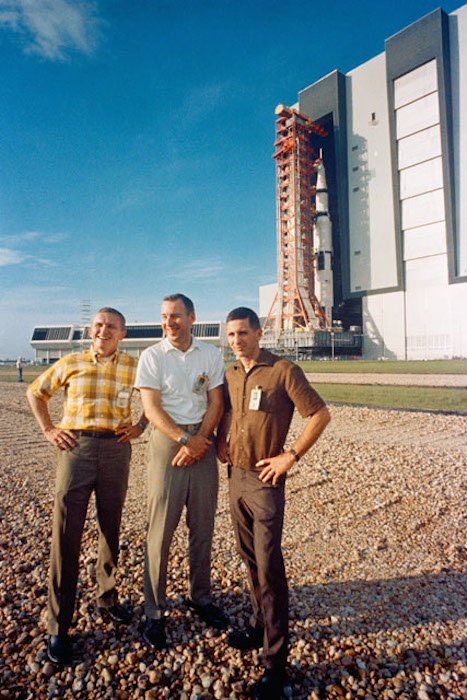
S68-49397 (9 Oct. 1968) --- The Apollo 8 prime crew stands in foreground as the Apollo (Spacecraft 103/Saturn 503) space vehicle leaves the Kennedy Space Center's Vehicle Assembly Building on way to Pad A, Launch Complex 39. The Saturn V stack and its mobile launch tower are atop a huge crawler-transporter. The Apollo 8 crew consists of (left to right) astronauts Frank Borman, commander; James A. Lovell Jr., command module pilot; and William A. Anders, lunar module pilot.
.

S68-49399 (9 Oct. 1968) --- The Apollo 8 (Spacecraft 103/Saturn 503) space vehicle on the way from the Kennedy Space Center's (KSC) Vehicle Assembly Building (VAB) to Pad A, Launch Complex 39. The Saturn V stack and its mobile launch tower are atop a huge crawler-transporter.
.
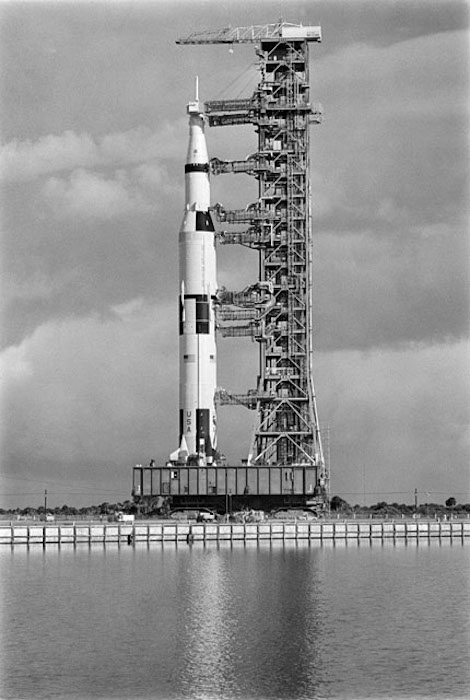
S68-49405 (9 Oct. 1968) --- The Apollo 8 (Spacecraft 103/Saturn 503) space vehicle on way from Kennedy Space Center's (KSC) Vehicle Assembly Building (VAB) to Pad A, Launch Complex 39. The Saturn V stack and its mobile launch tower are atop a huge crawler-transporter. (Ground level view, looking across water.)
.

S68-50265 (13 Nov. 1968) --- These three astronauts are the prime crew of the Apollo 8 lunar orbit mission. Left to right, are James A. Lovell Jr., command module pilot; William A. Anders, lunar module pilot; and Frank Borman, commander. They are standing beside the Apollo Mission Simulator at the Kennedy Space Center (KSC).
.

S68-50646 (18 Oct. 1968) --- The prime crew of the Apollo 8 mission is photographed in Building 4, at the Manned Spacecraft Center (MSC), where they are participating in classroom work in burn test review and procedures review. Left to right, are astronauts James A. Lovell Jr., William A. Anders, and Frank Borman.
.

S68-51302 (December 1968) --- North American Rockwell artist's concept illustrating a phase of the Apollo 8 lunar orbit mission. Here, after 20 hours of lunar orbit, Apollo 8 astronauts start the 20,500-pound thrust engine and head for home. The service module engine will fire about three minutes, starting up while the spacecraft is at the darkened, backside of the moon and blocked from communication with Earth.
.
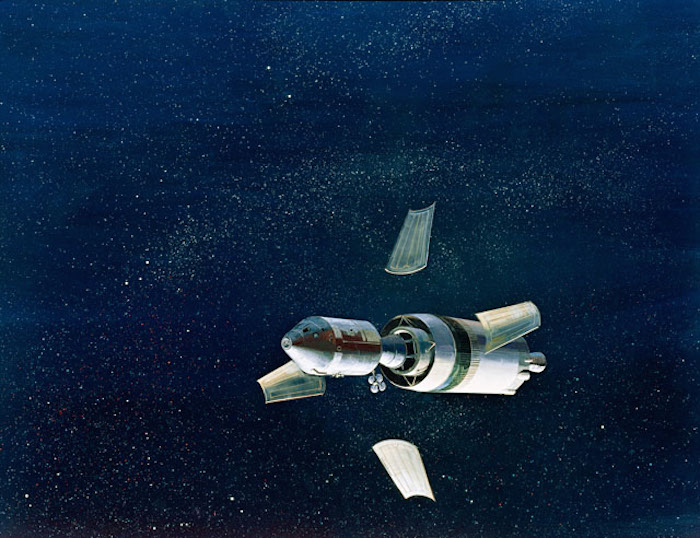
S68-51306 (December 1968) --- North American Rockwell artist's concept illustrating a phase of the scheduled Apollo 8 lunar orbit mission. Here, the Apollo 8 spacecraft lunar module adapter (SLA) panels, which have supported the Command and Service Modules, are jettisoned. This is done by astronauts firing the service module reaction control engines. A signal simultaneously deploys and jettisons the panels, separating the spacecraft from the SLA and deploying the high gain (deep space) antenna.
.

S68-52941 (25 Oct. 1968) --- The Apollo 8 prime crew is seen inside Apollo Boilerplate 1102A during water egress training in the Gulf of Mexico. From the foreground are astronauts Frank Borman, commander; James A. Lovell Jr., command module pilot; and William A. Anders, lunar module pilot.
.

S68-53015 (25 Oct. 1968) --- Astronauts Frank Borman, James A. Lovell Jr., and William A. Anders (left to right) are seen inside Apollo Boilerplate 1102A during water egress training in the Gulf of Mexico. Borman is Apollo 8 commander; with Lovell serving as command module pilot; and Anders as lunar module pilot.
.

S68-53186 (1 Nov. 1968) --- Astronaut Frank Borman, Apollo 8 commander, egresses the gondola in Building 29 after centrifuge training in the Manned Spacecraft Center's (MSC) Flight Acceleration Facility (FAF).
.
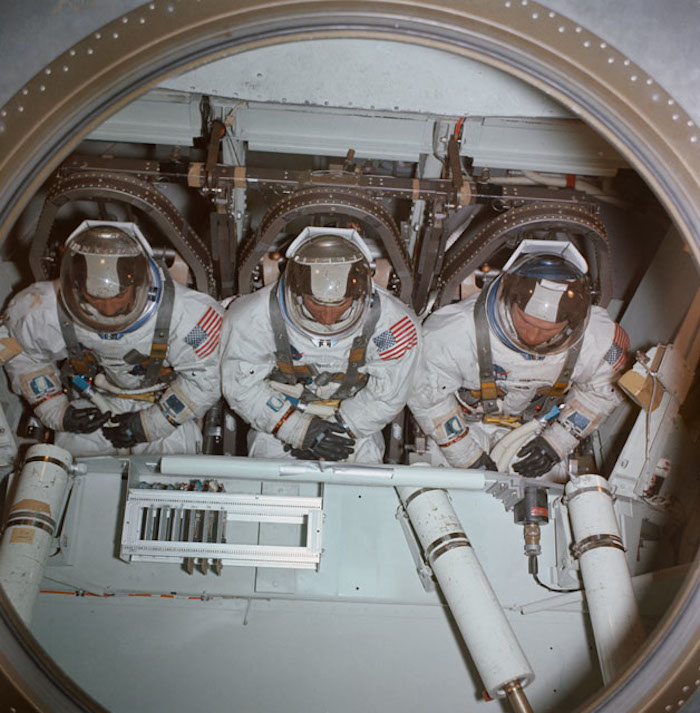
S68-53194 (1 Nov. 1965) --- The Apollo 8 prime crew inside the centrifuge gondola in Building 29 during centrifuge training in MSC's Flight Acceleration Facility. (View with crew lying on back) Left to right, are astronauts Frank Borman, commander; James A. Lovell Jr., command module pilot; and William A. Anders, lunar module pilot.
.

S68-53223 (19 Oct. 1968) --- The prime crew of the Apollo 8 mission in life raft awaiting pickup by U.S. Coast Guard helicopter during water egress training in the Gulf of Mexico. They had just egressed Apollo Boilerplate 1102A, at left. Inflated bags were used to upright the boilerplate. Left to right, are astronauts William A. Anders, lunar module pilot; and Frank Borman, commander. A team of MSC swimmers assisted with the training exercise.
.
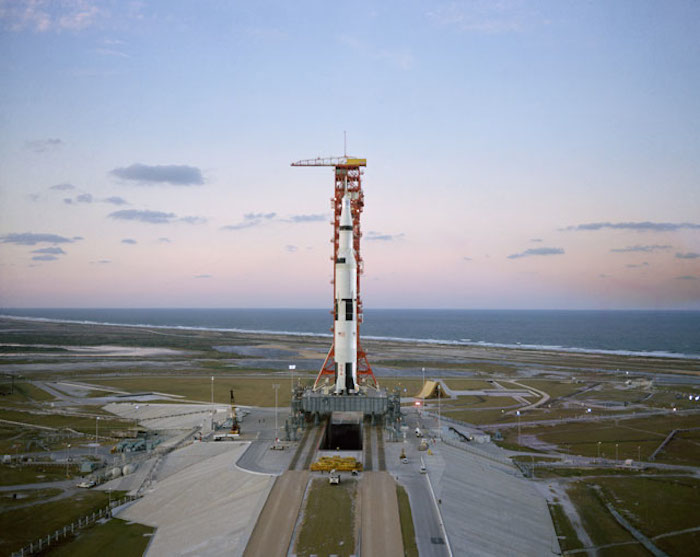
S68-55416 (17 Dec. 1968) --- High-angle view of the Apollo 8 (Spacecraft 103/Saturn 503) space vehicle at Pad A, Launch Complex 39, Kennedy Space Center (KSC). The Apollo 8 stack was photographed during a prelaunch alert-mobile service structure pull back.
.

S68-55424 (17 Dec. 1968) --- Ground-level view of the Apollo 8 (Spacecraft 103/Saturn 503) space vehicle at Pad A, Launch Complex 39, Kennedy Space Center (KSC). The Apollo 8 stack was photographed during a prelaunch alert-mobile service structure pull back. (Mobile launch tower on left and mobile service structure on right.)
.
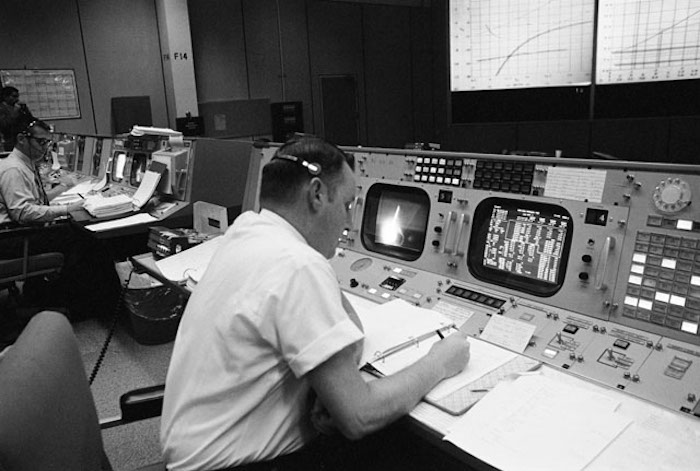
S68-55742 (21 Dec. 1968) --- Clifford E. Charlesworth, Apollo 8 "Green Team" flight director, is seated at his console in the Mission Operations Control Room in the Mission Control Center, Building 30, during the launch of the Apollo 8 (Spacecraft 103/Saturn 503) manned lunar orbit space mission.
.
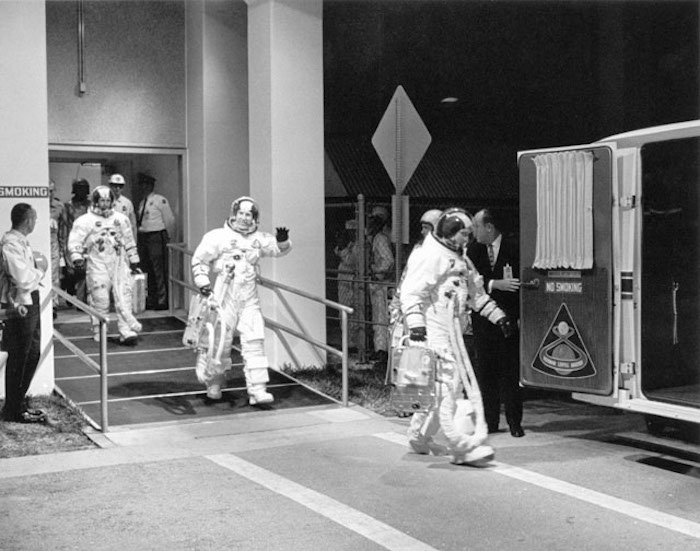
S68-55997 (21 Dec. 1968) --- Apollo 8 Command Module Pilot James Lovell waves to well-wishers during the pre-dawn departure to Launch Pad 39 for the six-day lunar orbital Apollo/Saturn V mission. Astronaut Lovell is accompanied by Commander Frank Borman, right, and Lunar Module Pilot William Anders, left.
.

S68-55999 (21 Dec. 1968) --- The Apollo 8 crew leaves the Kennedy Space Center's (KSC) Manned Spacecraft Operations Building (MSOB) during the Apollo 8 prelaunch countdown. Astronaut Frank Borman (waving to well-wishers), commander, leads followed by astronauts James A. Lovell Jr., command module pilot; and William A. Anders, lunar module pilot. The crew is about to enter a special transfer van which transported them to Pad A, Launch Complex 39, where their Apollo 8 (Spacecraft 103/Saturn 503) space vehicle awaited them. Liftoff for the lunar orbit mission was at 7:51 a.m. (EST). Holding the door to the transfer van is Charles Buckley, KSC security chief.
.

S68-56002 (21 Dec. 1968) --- The Apollo 8 (Spacecraft 103/Saturn 503) space vehicle is launched from Pad A, Launch Complex 39, Kennedy Space Center (KSC), at 7:51 a.m. (EST), Dec. 21, 1968. The crew of the Apollo 8 lunar orbit mission is astronauts Frank Borman, commander; James A. Lovell Jr., command module pilot; and William A. Anders, lunar module pilot. Apollo 8 was the first manned Saturn V launch. (F-ls 1/3 way from top of mobile launch tower.)
.

S68-56050 (21 Dec. 1968)--- The Apollo 8 (Spacecraft 103/Saturn 503) space vehicle is launched from Pad A, Launch Complex 39, Kennedy Space Center (KSC), at 7:51 a.m. (EST), Dec. 21, 1968. The crew of the Apollo 8 lunar orbit mission is astronauts Frank Borman, commander; James A. Lovell Jr., command module pilot; and William A. Anders, lunar module pilot. Apollo 8 is the first manned Saturn V launch. (water in foreground, seagulls)
.

S68-56007 (23 Dec. 1968) --- Overall view of the Mission Operations Control Room in the Mission Control Center, Building 30, on the third day of the Apollo 8 lunar orbit mission. Seen on the television monitor is a picture of Earth which was telecast from the Apollo 8 spacecraft 176,000 miles away.
.

S68-56045 (26 Dec. 1968) --- Television viewers saw this picture of Earth during the sixth live telecast from the Apollo 8 spacecraft as it continued its journey home. At the time this picture was made, the Apollo 8 spacecraft, with astronauts Frank Borman, commander; James A. Lovell Jr., command module pilot; and William A. Anders, lunar module pilot, aboard, was about 97,000 nautical miles from Earth, and was traveling at a speed of 6,084 feet per second. As the spacecraft continued its trans-Earth course, the Apollo 8 crew noted that "Earth was getting larger" and that they were looking forward to being home.
.

S68-56531 (21-27 Dec. 1968) --- Astronaut Frank Borman, mission commander, is shown during intravehicular activity (IVA) on the Apollo 8 lunar orbit mission. This still print was made from movie film exposed by an onboard 16mm motion picture camera.
.

S68-56532 (21-27 Dec. 1968) --- Astronaut William A. Anders, lunar module pilot, is shown during intravehicular activity (IVA) on the Apollo 8 lunar orbit mission. This still print was made from movie film taken by an onboard 16mm motion picture camera.
.

S68-56533 (21-27 Dec. 1968) --- Astronaut James A. Lovell Jr., command module pilot, is shown during intravehicular activity (IVA) on the Apollo 8 lunar orbit mission. This still print was made from movie film taken by an onboard 16mm motion picture camera.
.

S69-35097 (21-27 Dec. 1968) --- Astronaut James A. Lovell Jr., Apollo 8 command module pilot, is seen at the Apollo 8 Spacecraft Command Module's Guidance and Navigation station during the Apollo 8 lunar orbit mission. This picture was taken from 16mm motion picture film.
.

AS08-16-2583 (21 Dec. 1968) --- This is a photograph taken from the Apollo 8 spacecraft looking back at the Saturn V third (S-IVB) stage from which the spacecraft had just separated following trans-lunar injection. Attached to the S-IVB is the Lunar Module Test Article (LTA) which simulated the mass of a Lunar Module (LM) on the Apollo 8 lunar orbit mission. The 29-feet panels of the Spacecraft LM Adapter which enclosed the LTA during launch have already been jettisoned and are out of view. Sunlight reflected from small particles shows the "firefly" phenomenon which was reported by astronaut John H. Glenn Jr. during the first Earth-orbital flight, Mercury-Atlas 6 (MA-6) of the Mercury Program.
.

AS08-16-2582 (21 Dec. 1968) --- This is a photograph taken from the Apollo 8 spacecraft looking back at the Saturn V third (S-IVB) stage from which the spacecraft had just separated following trans-lunar injection. (Hold picture with S-IVB at top center). Attached to the S-IVB is the Lunar Module Test Article (LTA) which simulated the mass of a Lunar Module (LM) on the Apollo 8 lunar orbit mission. The 29-feet panels of the Spacecraft LM Adapter which enclosed the LTA during launch have already been jettisoned and are out of view. Sunlight reflected from small particles shows the "firefly" phenomenon which was reported by astronaut John H. Glenn Jr. during the first Earth-orbital flight (Mercury-Atlas 6) of the Mercury Program.
.
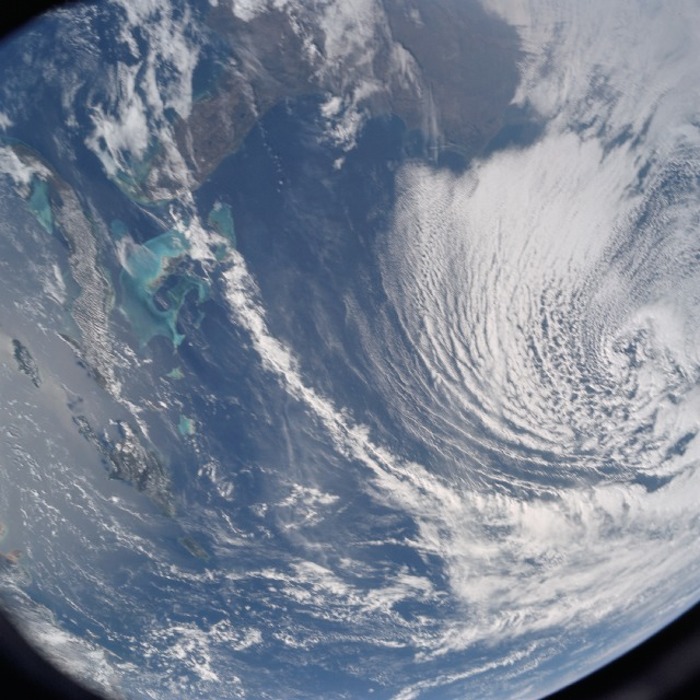
AS08-16-2581 (21-27 Dec. 1968) --- This photograph of Earth was taken from the Apollo 8 spacecraft while it was in Earth orbit. Most of the southeastern United States and the Caribbean Sea area, the U.S. coastline from Chesapeake Bay to the Florida Peninsula can be seen. The Bahamas and the islands of Cuba, Jamaica, Hispaniola and Puerto Rico extend across the Caribbean, the light blue of the shallow Bahama banks contrasting sharply with the darker hue of the deeper water, especially in the Tongue of the Ocean area.
.
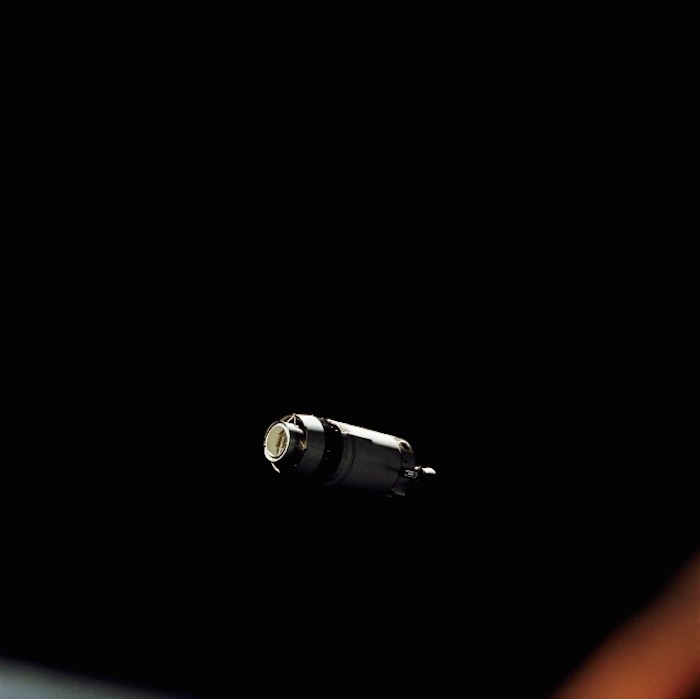
S08-16-2584 (21 Dec. 1968) --- This is a photograph taken from the Apollo 8 spacecraft looking back at the Saturn V third (S-IVB) stage from which the spacecraft had just separated following trans-lunar injection. Attached to the S-IVB is the Lunar Module Test Article (LTA) which simulated the mass of a Lunar Module (LM) on the Apollo 8 lunar orbit mission. The 29-feet panels of the Spacecraft LM Adapter which enclosed the LTA during launch have already been jettisoned and are out of view. Sunlight reflected from small particles shows the "firefly" phenomenon which was reported by astronaut John H. Glenn Jr. during the first Earth-orbital flight, Mercury-Atlas 6 (MA-6) of the Mercury Program.
.

AS08-14-2505 (21-27 Dec. 1968) --- This photograph of a nearly full moon was taken from the Apollo 8 spacecraft at a point above 70 degrees east longitude. (Hold picture with moon's dark portion at left). Mare Crisium, the circular, dark-colored area near the center, is near the eastern edge of the moon as viewed from Earth. Mare Nectaris is the circular mare near the terminator. The large, irregular maira are Tranquillitatis and Fecunditatis. The terminator at left side of picture crosses Mare Tranquillitatis and highlands to the south. Lunar farside features occupy most of the right half of the picture. The large, dark-colored crater Tsiolkovsky is near the limb at the lower right. Conspicuous bright rays radiate from two large craters, one to the north of Tsiolkovsky, the other near the limb in the upper half of the picture. These rayed craters were not conspicuous in Lunar Orbiter photography due to the low sun elevations when the Lunar Orbiter photography was made. The crater Langrenus is near the center of the picture at the eastern edge of Mare Fecunditatis. The lunar surface probably has less pronounced color that indicated by this print.
.

AS08-14-2453 (21-27 Dec. 1968) --- After inserting into lunar orbit, the Apollo 8 astronauts looked down on rugged terrain never before seen by man. This scene is typical of farside terrain illuminated by a sun that is nearly directly overhead. A surface consisting of craters superimposed on older craters extends about 570 kilometers (350 statute miles) to the horizon. Width of view at the horizon is 150 kilometers (94 statute miles).
.
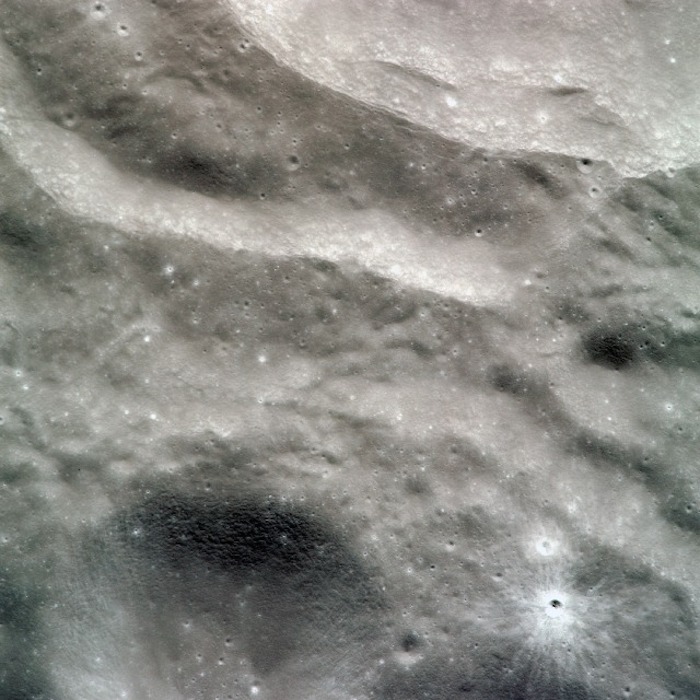
AS08-14-2432 (21-27 Dec. 1968) --- This is a near vertical photograph of the lunar surface taken with a telephoto lens during the Apollo 8 lunar orbit mission. The photographed area is approximately 20 miles on a side and is located within a large, unmanned 100-miles-in-diameter crater on the farside of the moon. This large crater is located at 10 degrees south latitude and 160 degrees east longitude. The lunar surface probably has less pronounced color then indicated by this print.
.

AS08-12-2196 (21-27 Dec. 1968) --- An oblique view from the Apollo 8 spacecraft looking eastward across the lunar surface from about 115 degrees east longitude to the horizon near 180 degrees east longitude. The crater Tsiolkovsky in the center of the picture is 150 kilometers wide and is located at 129 degrees east longitude and 21 degrees south latitude. While in lunar orbit, Apollo 8 moved toward the camera position over the terrain along the left (north) side of this photograph.
.
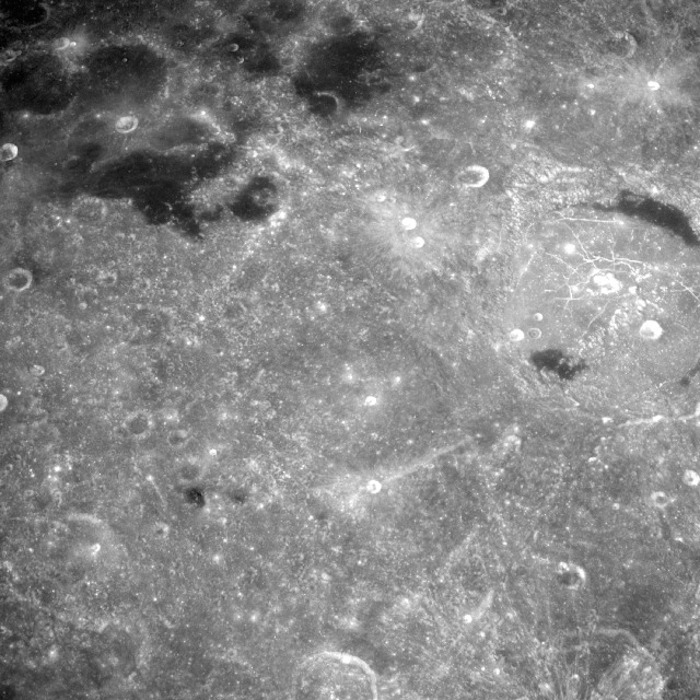
AS08-12-2193 (21-27 Dec. 1968) --- View of the lunar surface taken from the Apollo 8 spacecraft looking southward from high altitude across the Southern Sea. (Hold picture with AS8 number in upper right corner). The bright-rayed crater near the horizon is located near 130 degrees east longitude and 70 degrees south latitude. The dark-floored crater near the middle of the right side of the photograph is about 70 kilometers (45 statute miles) in diameter. Both features are beyond the eastern limb of the moon as viewed from Earth; neither has a name.
.

AS08-13-2224 (21-27 Dec. 1968) --- This oblique view of the lunar surface was taken from the Apollo 8 spacecraft looking southward toward Goclenius and other large craters near 45 degrees east longitude and 10 degrees south latitude in the Sea of Fertility. Goclenius, the crater in the foreground with a rille-broken flat floor, is about 70 kilometers (45 statute miles) in diameter. One rille, approximately horizontal in this view, crosses both crater rims and the central peak, and, on adjoining Apollo 8 photographs, can be traced several kilometers across the mare surface beyond the high crater wall. In the background, the two large craters with smooth floors are Colombo A (left) and Magelhaens. Magelhaens A, the crater with the irregular floor, is about 35 kilometers (20 statute miles) in diameter.
.

AS08-12-2052 (21-27 Dec. 1968) --- This near-vertical photograph from the Apollo 8 spacecraft covers an area of approximately 50 x 50 statute miles within a 250-statute-miles-in-diameter crater on the lunar farside. The center of this large crater is located at about 157 degrees west longitude and 4 degrees south latitude. The large crater in the center of the picture is about 20 statute miles in diameter.
.

S08-13-2244 (21-27 Dec. 1968) --- This Apollo 8 view of the lunar surface looks southward at 162 degrees west longitude, showing rugged terrain that is characteristic of the lunar farside hemisphere. Hold picture with black sky at top right. The large crater at the left side of the picture is about 110 kilometers (70 statute miles) in diameter and is centered about 200 kilometers (125 statute miles) south of the spacecraft. The sharp, circular crater in the foreground is about 15 kilometers (9 statute miles) across. Conspicuous surface lineations that extend from the lower right corner of the photograph toward the upper left resemble a radial texture observed near Mare Orientale on Lunar Orbiter IV photographs. The lineations in this area probably are related to another major crater because the observed trend is not radial to Mare Orientale.
.

AS08-13-2252 (21-27 Dec. 1968) --- Oblique view of the lunar surface taken from the Apollo 8 spacecraft looking southward across the farside crater Tsiolkovsky which is centered near 129 degrees east longitude and 21 degrees south latitude. The flat floor of Tsiolkovsky is much darker than the surrounding lunar surface. It is darker than most of the mare material observed by the Apollo 8 crew. The dark material is about 125 kilometers (80 statute miles) across measured from the near-to far-side contacts in this view. The central peak, which stands as an "island" within the dark material, is about 40 kilometers (25 statute miles) long. High sun angle at the time of this photograph accentuates the contrast between light and dark material and degrades the ability to detect topographic details. The only boulders observed by the Apollo 8 crew had rolled from the light-colored peak onto the dark, smooth surface near the right hand end of the peak.
.

AS08-13-2344 (21-27 Dec. 1968) --- This oblique photograph looks generally northwest from the Apollo 8 spacecraft into the Sea of Tranquility. (HOLD PICTURE WITH LARGE TRIANGLE FORMED BY DARK SKY AT UPPER LEFT). The three prominent craters are Taruntius F in the lower right corner; Taruntius E in the center; and Cauchy between the two linear features. The Cauchy scarp, this side of the Cauchy crater, is formed by one to three faults stepped down toward the spacecraft. Cauchy Rille, on the other side of Cauchy crater, consists of several arcuate segments of a graben. Each of the three prominent craters is 10 to 15 kilometers (6 to 9 statute miles) across.
.
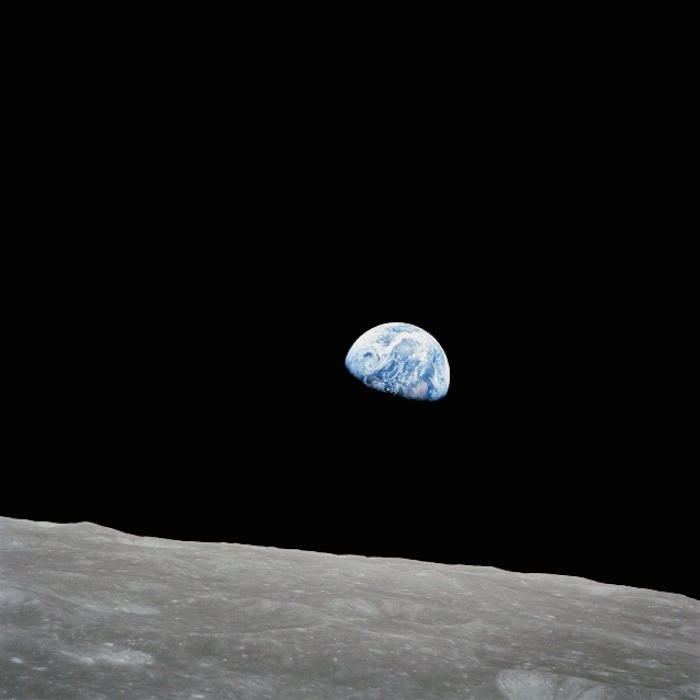
AS08-14-2383 (24 Dec. 1968) --- The rising Earth is about five degrees above the lunar horizon in this telephoto view taken from the Apollo 8 spacecraft near 110 degrees east longitude. The horizon, about 570 kilometers (350 statute miles) from the spacecraft, is near the eastern limb of the moon as viewed from Earth. Width of the view at the horizon is about 150 kilometers (95 statute miles). On Earth 240,000 statute miles away the sunset terminator crosses Africa. The crew took the photo around 10:40 a.m. Houston time on the morning of Dec. 24, and that would make it 15:40 GMT on the same day. The South Pole is in the white area near the left end of the terminator. North and South America are under the clouds.
.

AS08-16-2593 (21-27 Dec. 1968) --- A striking view from the Apollo 8 spacecraft showing nearly the entire Western Hemisphere, from the mouth of the St. Lawrence River, including nearby Newfoundland, extending to Tierra del Fuego at the southern tip of South America. Central America is clearly outlined. Nearly all of South America is covered by clouds, except the high Andes Mountain chain along the west coast. A small portion of the bulge of West Africa shows along the sunset terminator.
.

AS08-16-2608 (21-27 Dec. 1968) --- A view of the Western Hemisphere from the Apollo 8 spacecraft. The sunset terminator runs from eastern Brazil to northeastern United States. A large area of the U.S. and Mexico, from Baja California to the Mississippi Valley, is cloud-free. South America is at center, with clouds covering all but the Andes Mountains along the west coast. The Antarctic ice cap is also visible.
.

AS8-18-2883 (21-27 Dec. 1968) --- An Apollo 8 photograph of the surface of the moon. HOLD PICTURE WITH SKY AT TOP. The dark-floored crater in the lower right corner is named Lomonosov, and measures approximately 50 statute miles in diameter. The bright-rayed crater was named Giordano Bruno by the Russians. Bruno was a sixteenth-century Italian scientist. Lomonosov is located on the lunar farside at about 102 degrees east longitude and 28 degrees north latitude.
.
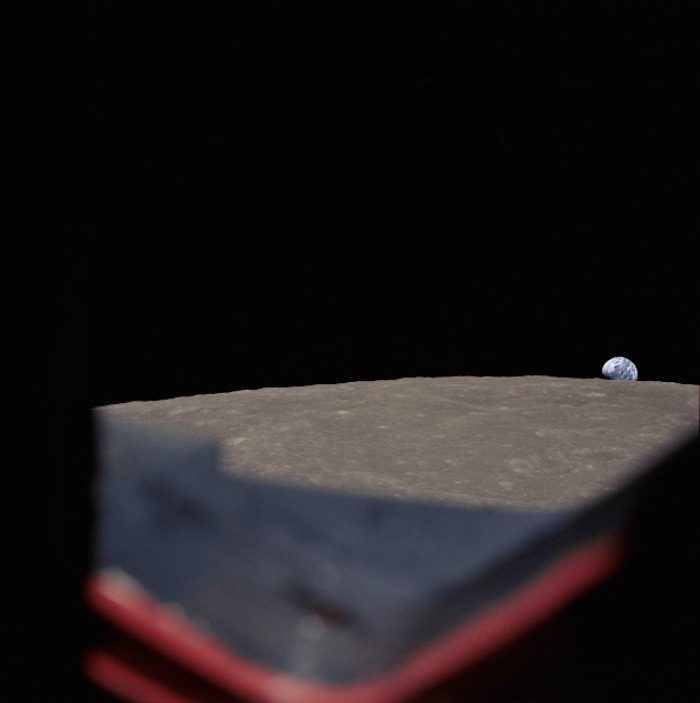
AS8-14-2392 (21-27 Dec. 1968) --- High-oblique view of the moon's surface showing Earth rising above the lunar horizon, looking west-southwest, as photographed from the Apollo 8 spacecraft as it orbited the moon. The center of the picture is located at about 105 degrees east longitude and 13 degrees south latitude. The lunar surface probably has less pronounced color than indicated by this print.
.

S68-55815 (24 Dec. 1968) --- This is how the surface of the moon looked from an altitude of approximately 60 miles as photographed by a television camera onboard the Apollo 8 spacecraft. This is Apollo 8's third live television transmission back to Earth. At the time this picture was made, the Apollo 8 spacecraft, with astronauts Frank Borman, James A. Lovell Jr., and William A. Anders aboard, was making its second revolution of the moon.
.

S68-55292 (August 1968) --- A North American Rockwell Corporation artist's concept depicting the Apollo Command Module (CM), oriented in a blunt-end-forward attitude, re-entering Earth's atmosphere after returning from a lunar landing mission. Note the change in color caused by the extremely high temperatures encountered upon re-entry.
.

S69-15592 (27 Dec. 1968) --- This Apollo 8 re-entry photograph was taken by U.S. Air Force Airborne Lightweight Optical Tracking System (ALOTS) camera mounted on a KC-135-A aircraft flown at 40,000 feet altitude. Apollo 8, with astronauts Frank Borman, James A. Lovell Jr., and William A. Anders aboard, splashed down at 10:51 a.m. (EST) Dec. 27, 1968, in the central Pacific approximately 1,000 miles south-southwest of Hawaii.
.

S68-56304 (27 Dec. 1968) --- The Apollo 8 capsule is seen being hoisted aboard the recovery carrier, USS Yorktown after its successful splashdown.
.

S69-15732 (27 Dec. 1968) --- A U.S. Navy frogman team participates in the Apollo 8 recovery operations. The Apollo crew, astronauts Frank Borman, James A. Lovell Jr., and William A. Anders, were recovered by helicopter and flown to the deck of the USS Yorktown, prime recovery ship for the historic Apollo 8 lunar orbit mission. Apollo 8 splashed down at 10:51 a.m. (EST), Dec. 27, 1968, about 1,000 miles south-southwest of Hawaii.
.
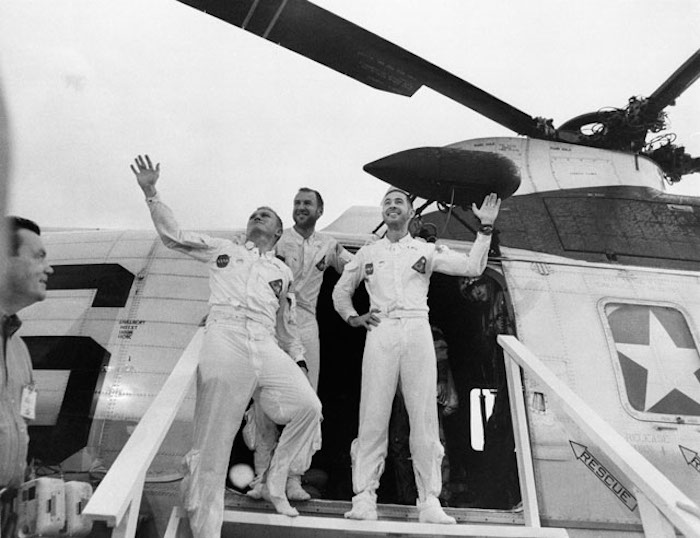
S69-15737 (27 Dec. 1968) --- The Apollo 8 crew stands in the doorway of a recovery helicopter after arriving aboard the carrier USS Yorktown, prime recovery ship for the historic Apollo 8 lunar orbit mission. Left to right, are astronauts Frank Borman, commander; James A. Lovell Jr., command module pilot; and William A. Anders, lunar module pilot. Apollo 8 splashed down at 10:51 a.m. (EST), Dec. 27, 1968, in the central Pacific approximately 1,000 miles south-southwest of Hawaii.
.

S69-16402 (29 Dec. 1968) --- Although it was past 2 a.m., a crew of more than 2,000 people were on hand at Ellington Air Force Base to welcome the members of the Apollo 8 crew back home. Astronauts Frank Borman, James A. Lovell Jr., and William A. Anders had just flown to Houston from the pacific recovery area by way of Hawaii. The three crewmen of the historic Apollo 8 lunar orbit mission are standing at the microphones in center of picture.
.
Quelle: NASA
5424 Views
